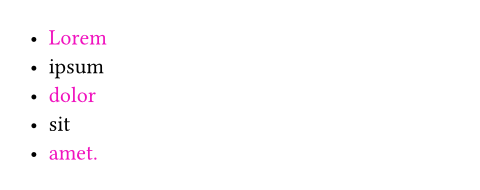state
Manages stateful parts of your document.
Let's say you have some computations in your document and want to remember the result of your last computation to use it in the next one. You might try something similar to the code below and expect it to output 10, 13, 26, and 21. However this does not work in Typst. If you test this code, you will see that Typst complains with the following error message: Variables from outside the function are read-only and cannot be modified.
// This doesn't work!
#let star = 0
#let compute(expr) = {
star = eval(
expr.replace("⭐", str(star))
)
[New value is #star.]
}
#compute("10") \
#compute("⭐ + 3") \
#compute("⭐ * 2") \
#compute("⭐ - 5")
State and document markup
Why does it do that? Because, in general, this kind of computation with side effects is problematic in document markup and Typst is upfront about that. For the results to make sense, the computation must proceed in the same order in which the results will be laid out in the document. In our simple example, that's the case, but in general it might not be.
Let's look at a slightly different, but similar kind of state: The heading numbering. We want to increase the heading counter at each heading. Easy enough, right? Just add one. Well, it's not that simple. Consider the following example:
#set heading(numbering: "1.")
#let template(body) = [
= Outline
...
#body
]
#show: template
= Introduction
...
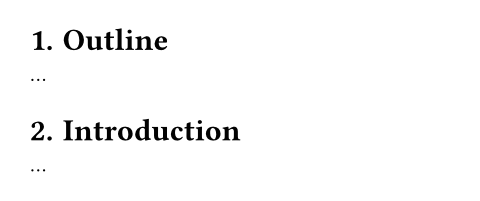
Here, Typst first processes the body of the document after the show rule,
sees the Introduction heading, then passes the resulting content to the
template function and only then sees the Outline. Just counting up would
number the Introduction with 1 and the Outline with 2.
Managing state in Typst
So what do we do instead? We use Typst's state management system. Calling
the state function with an identifying string key and an optional initial
value gives you a state value which exposes a few functions. The two most
important ones are get and update:
-
The
getfunction retrieves the current value of the state. Because the value can vary over the course of the document, it is a contextual function that can only be used when context is available. -
The
updatefunction modifies the state. You can give it any value. If given a non-function value, it sets the state to that value. If given a function, that function receives the previous state and has to return the new state.
Our initial example would now look like this:
#let star = state("star", 0)
#let compute(expr) = {
star.update(old =>
eval(expr.replace("⭐", str(old)))
)
[New value is #context star.get().]
}
#compute("10") \
#compute("⭐ + 3") \
#compute("⭐ * 2") \
#compute("⭐ - 5")
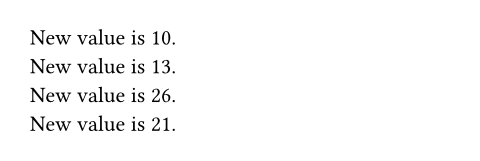
State managed by Typst is always updated in layout order, not in evaluation
order. The update method returns content and its effect occurs at the
position where the returned content is inserted into the document.
As a result, we can now also store some of the computations in variables, but they still show the correct results:
...
#let more = [
#compute("⭐ * 2") \
#compute("⭐ - 5")
]
#compute("10") \
#compute("⭐ + 3") \
#more
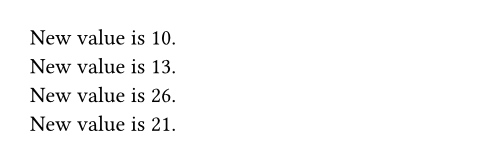
This example is of course a bit silly, but in practice this is often exactly what you want! A good example are heading counters, which is why Typst's counting system is very similar to its state system.
Time Travel
By using Typst's state management system you also get time travel
capabilities! We can find out what the value of the state will be at any
position in the document from anywhere else. In particular, the at method
gives us the value of the state at any particular location and the final
methods gives us the value of the state at the end of the document.
...
Value at `<here>` is
#context star.at(<here>)
#compute("10") \
#compute("⭐ + 3") \
*Here.* <here> \
#compute("⭐ * 2") \
#compute("⭐ - 5")
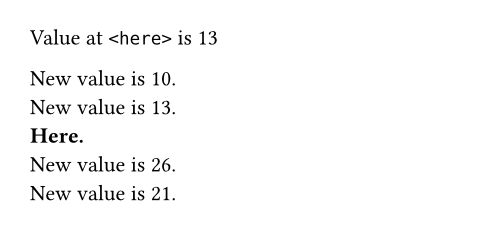
A word of caution
To resolve the values of all states, Typst evaluates parts of your code multiple times. However, there is no guarantee that your state manipulation can actually be completely resolved.
For instance, if you generate state updates depending on the final value of
a state, the results might never converge. The example below illustrates
this. We initialize our state with 1 and then update it to its own final
value plus 1. So it should be 2, but then its final value is 2, so it
should be 3, and so on. This example displays a finite value because Typst
simply gives up after a few attempts.
// This is bad!
#let x = state("key", 1)
#context x.update(x.final() + 1)
#context x.get()

In general, you should try not to generate state updates from within context expressions. If possible, try to express your updates as non-contextual values or functions that compute the new value from the previous value. Sometimes, it cannot be helped, but in those cases it is up to you to ensure that the result converges.
Constructor
Create a new state identified by a key.
key
The key that identifies this state.
Any updates to the state will be identified with
the string key. If you construct multiple states with the same
key, then updating any one will affect all of them.
init any Positional
The initial value of the state.
If you construct multiple states with the same key but different
init values, they will each use their own initial value but share
updates. Specifically, the value of a state at some location in the
document will be computed from that state's initial value and all
preceding updates for the state's key.
 View example
View example
#let banana = state("key", "🍌")
#let broccoli = state("key", "🥦")
#banana.update(it => it + "😋")
#context [
- #state("key", "🍎").get()
- #banana.get()
- #broccoli.get()
]

Default: none
Definitions
getContextual
Retrieves the value of the state at the current location.
This is equivalent to state.at(here()).
atContextual
Retrieves the value of the state at the given selector's unique match.
The selector must match exactly one element in the document. The most
useful kinds of selectors for this are labels and
locations.
selector
The place at which the state's value should be retrieved.
finalContextual
Retrieves the value of the state at the end of the document.
update
Updates the value of the state.
Returns an invisible piece of content that must be inserted into the document to take effect. This invisible content tells Typst that the specified update should take place wherever the content is inserted into the document.
State is a part of your document and runs like a thread embedded in the document content. The value of a state is the result of all state updates that happened in the document up until that point.
That's why state.update returns an invisible sliver of content that
you need to return and include in the document — a state update that is
not "placed" in the document does not happen, and "when" it happens is
determined by where you place it. That's also why you need context to
read state: You need to use the current document position to know where
on the state's "thread" you are.
Storing a state update in a variable (e.g.
let my-update = state("key").update(c => c * 2)) will have no effect
by itself. Only once you insert the variable #my-update somewhere
into the document content, the update will take effect — at the position
where it was inserted. You can also use #my-update multiple times at
different positions. Then, the update will take effect multiple times as
well.
In contrast to get, at, and
final, this function does not require context. This
is because, to create the state update, we do not need to know where in
the document we are. We only need this information to resolve the
state's value.
update
A value to update to or a function to update with.
- If given a non-function value, sets the state to that value.
- If given a function, that function receives the state's previous value and has to return the state's new value.
When updating the state based on its previous value, you should prefer the function form instead of retrieving the previous value from the context. This allows the compiler to resolve the final state efficiently, minimizing the number of layout iterations required.
In the following example, fill.update(f => not f) will paint odd
items in the bullet list as expected. However, if it's
replaced with context fill.update(not fill.get()), then layout
will not converge within 5 attempts, as each update will take one
additional iteration to propagate.
 View example
View example
#let fill = state("fill", false)
#show list.item: it => {
fill.update(f => not f)
context {
set text(fill: fuchsia) if fill.get()
it
}
}
#lorem(5).split().map(list.item).join()
